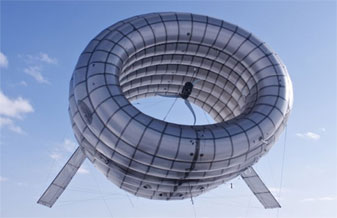Did you ever wonder why advances in wind turbines seem to make them ever higher? A typical offshore wind turbine is some 479 feet high, about the height of a 20-story building.
The higher the wind turbine is, the better it can catch stronger winds. Wind turbines at ground level only have energy output of 20-25%, but that can double when they 600-1000 off the ground.
That’s what Altareos Energies is working on – a turbine that floats in the air. And it’s turbine will float higher than 1000 feet.

Altaeros says its first product reduces energy costs up to 65% by harnessing stronger winds at over 1,000 feet high. Installation time is shortened from weeks to days, it requires minimal maintenance, and there’s virtually no environmental or noise impact.
This first turbine will displace expensive fuel used to power diesel generators at remote industrial, military, and village sites. In the long term, Altaeros plans to scale up the technology to reduce costs in the offshore wind market.
"For decades, wind turbines have required cranes and huge towers to lift a few hundred feet off the ground where winds can be slow and gusty," says Ben Glass, CEO. "We are excited to demonstrate that modern inflatable materials can lift wind turbines into more powerful winds almost everywhere – with a platform that is cost competitive and easy to setup from a shipping container."
A helium-filled, inflatable shell floats to higher altitudes where winds are more consistent and over five times stronger than those reached by traditional tower-mounted turbines. Strong tethers hold it steady and send electricity down to the ground.
The lifting technology is adapted from aerostats, industrial cousins of passenger blimps that for decades have lifted heavy communications and radar equipment into the air for long periods of time. Aerostats are rated to survive hurricane-level winds and have safety features that ensure a slow descent to the ground.
In December 2011, the Federal Aviation Administration (FAA) released draft guidelines allowing the new class of airborne wind systems to be sited under existing regulation.
Altaeros Energies won the 2011 ConocoPhillips Energy Prize, and has received funding from the U.S. Department of Agriculture, the California Energy Commission, and the Maine Technology Institute.
Makani Power is another company developing high flying wind turbines.
Here’s Altaeros Energies website:

what an eyesore
Read the article Robo Fossil Fuel Shill. “Over 1,000 feet up.” What is really ugly is the SelfRightious Wing deciet that causes 18 veterans to commit suicide a day.
Pardon me. That’s “Self Righteous Wing deciet”
Pardon me again. That’s Self Righteous Wing Deceit” That’s what’s as ugly as a taken life.
Like you could see it from the ground when it is over 1000 feet in the air.
How exciting! Yes, it’s ugly but with time new designs will appear. I love the idea. Let’s see where it takes us!